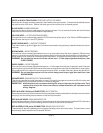
3 Wire Ground Switched Door Locks
In this application, the red wire provides a ground pulse during arming (pulsed ground lock) output.
Connect the red wire to the wire that provides a low current ground signal from the factory door lock switch to
the factory door lock control relay.
The green wire provides a ground pulse during disarming (pulsed ground unlock) output. Connect the
green wire to the wire that provides a low current ground signal from the factory door unlock switch to the
factory door lock control relay.
3 Wire Positive Switched Door Locks
In this application, the red wire provides a positive pulse during disarming (pulsed + 12 volt unlock) output.
Connect the red wire to the wire that provides a low current positive signal from the factory door unlock switch
to the factory door lock control relay.
The green wire provides a positive pulse during arming (pulsed + 12 volt lock) output. Connect the green
wire to the wire that provides a low current positive signal from the factory door lock switch to the factory door
lock control relay.
Resistive Circuits, As Well As 4 Wire Polarity Reversal and 5 Wire Alternating 12 Volt Door Lock
Control Circuits
These applications require the use of additional components which may include relays, fixed resistors, or for
convenience, the AS 9159 Door Lock Interface. Refer to the AUDIOVOX Door Lock Wiring Supplement and or
the Audiovox fax back service for information on your particular vehicle for properly connecting to these types
of circuits.
COMPLETING THE INSTALLATION
Antenna Wire : Be sure to extend the thin black antenna wire to it’s full length and cable tie into place where
it cannot be damaged. Avoid wrapping this wire around major, high current wire looms.
Adjusting the Shock Sensor : The sensitivity of the pre - detect circuit, where used, is automatically set 30%
less sensitive than the full trigger circuit.
Using a small screwdriver, gently turn the adjustment screw fully counterclockwise. ( DO NOT over turn this
screw. Maximum rotation for this adjustment is 270° ). Close the hood and trunk lids, and arm the alarm. Wait
6 seconds for the accessories trigger zone to stabilize, then firmly strike the rear bumper with the side of a
closed fist considering the amount of force required to break a window.
CAUTION : Never perform this test on the vehicle’s glass, as you may break the window.
Turn the adjustment screw clockwise ( increasing sensitivity ) about ¼ turn and re-test. Repeat this
procedure until the alarm sounds. Ultimately, one firm strike to the rear bumper will cause the alarm to emit
pre - detect warning tones.
WARNING ! Setting the sensitivity too high can cause false alarms due to noise vibrations from passing
trucks and heavy equipment. To decrease sensitivity, turn the adjustment screw counter clockwise.
Wire Dressing : Always wrap the alarm wires in convoluted tubing, or with a spiral wrap of electrical tape.
Secure these looms along the routing using cable ties. This will ensure that the alarm wires are not damaged
by falling onto hot or sharp moving surfaces in the vehicle.
Operation : Take a few moments to check off the appropriate option boxes in the owner’s manual and to fully
explain the operation of the system to your customer.
Page 5








